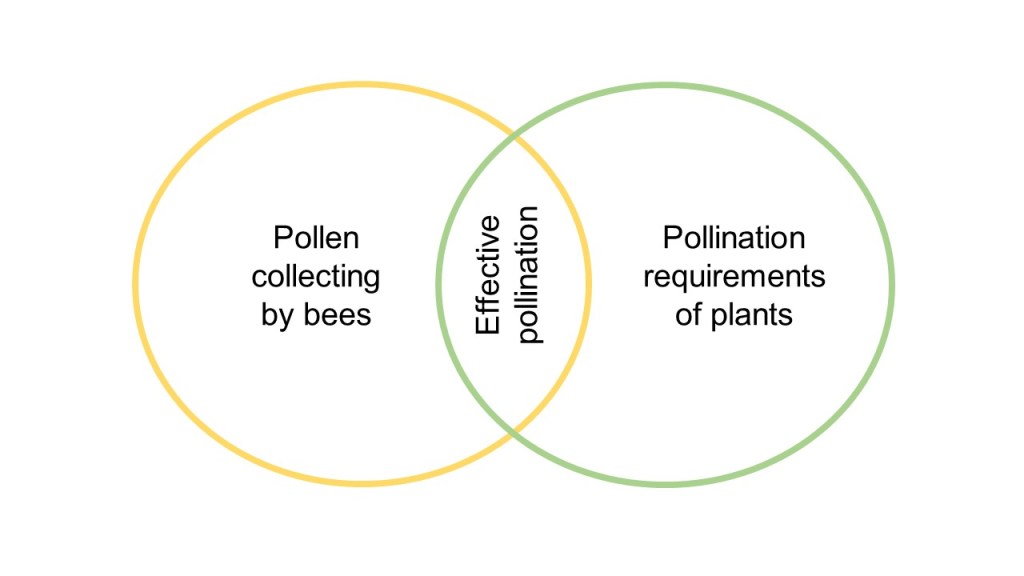
Obviously the title of this post is click-bait, as there’s LOTS of things that I wish more people knew about pollination! But here’s one that really gets my (Yule) goat.
I’ve lost track of the number of times that I’ve read statements in books and research papers such as “bees collect lots of pollen from flowers therefore they are good pollinators”. Even worse, I sometimes see studies where pollen has been removed from “pollen baskets” or other scopae, then used as a measure of the importance of those bees as pollinators.
In both cases it seems to have been forgotten that bees are collecting pollen to feed their larvae and pollen that ends up in scopae is generally not available for pollination.
That’s the purpose of the Venn diagram at the top of this short post, to remind us that there can be a disconnect between what bees are doing and what plants require: foraging for pollen only partly correlates with flower pollination. Indeed, the same argument applies to any animal that feeds itself or its young on pollen, including pollen wasps (Maserinae), Heliconia butterflies, and some flower-visiting hoverflies, birds and bats.
It’s not only loss of pollen from reproduction that’s important here: depending on the size and behaviour of the bees relative to the shape and size of the flower, they may go nowhere near the stigma, so even if they are carrying viable pollen, it can be lost as far as the plant is concerned.
Note also that many bee species will collect pollen from wind-pollinated plants such as grasses, oaks, etc. Indeed in some species the availability of such pollen is extremely important – see Manu Saunders’ review on this topic and more recent papers that cite it. Again, it emphasises the partial disconnect between pollen collecting by bees and pollination of flowers by bees.
Assessing which flower visitors are actually pollinators is not technically demanding but it can be time consuming. The minimum that you need is single visit deposition (SVD) experiments in which you expose unvisited flowers to one visit by the potential pollinator. Then you assess how much pollen has landed on the stigma or (better) whether the visit results in seed set.
If you want to know more about the evidence that’s required to determine if a flower visitor is or is not a pollinator, they are codified in the “Cox-Knox Postulates” that I discuss in my book Pollinators & Pollination: Nature and Society.

Reading this was a “duh” moment… I had never distinguished between pollen on scopae (for feeding pollinator’s young) and the adventitious pollen elsewhere on the pollinator’s body (sometimes) available for flower pollination. Thanks!
My work here is done 🙂
This problem is so old it goes back to the 19th century when the German botanists who followed the work of Darwin caught and recorded every insect visiting a flower implying that all of them were prospective pollinators. Yes, I’m aware that the same people also laid the groundwork for pollination syndromes. However, if the rational still goes “I caught this on that therefore it’s the pollinator” persists in our own publications before trickling down to a few enthusiastic science writers, who is really to blame?
I learned the importance of making pollen load analyses from captured or euthanized floral foragers from the later L.W. Macior. Fifty years later, my former grad students, post-docs, colleagues and I remain among the few to do so. How does anyone in the 21st century have the nerve to construct these complicated pollination networks without establishing that any animal species, its cast and/or sex transports the grains of any of the flowers it visits to receptive stigmas? In fact, most pollination networks shoujld be retitled flower visiting networks. I also think that, over the past half century, several people (e.g. L.A. Nilson), especially our Chinese colleagues, should be praised for their pioneer policies of measuring the dimensions of animal visitors versus the floral architecture of the plants they visited.
And here is a point you missed in your brief essay. How is it possible to identify primary pollinators of any plant species unless you have done tests and experiments to determine periods of stigmatic receptivity and whether self-incompatibility is expressed by the breeding system? The fidelity an animal shows to the flowers of a particular bush may mean nothing if it only deposits pollen on the stigma of flowers on the same bush or if it forages no further than clones made by the same plant or to nearby individuals consisting of its siblings, parents and grandparents. That is the basis for understanding the impact different floral foragers may have on reproductive success in plant species with sporophytic or gametophytic recognition/rejection systems. Depending on whom you quote it’s estimated that up to 66% of all angiosperm species have one or the other.
Thanks Peter. I think that all of us who construct and analyse networks recognise the issues, but the scale of doing SVDs, stigmatic receptivity tests, etc., in diverse communities is formidable. But we had to start somewhere and it’s starting to be done.
As I point out in my book, however, the architecture of networks stays much the same in terms of patterns such as nestedness and modularity, once you remove the non-pollinators. And flower visitation itself is an important interaction for the animal, even if it’s not for the plant